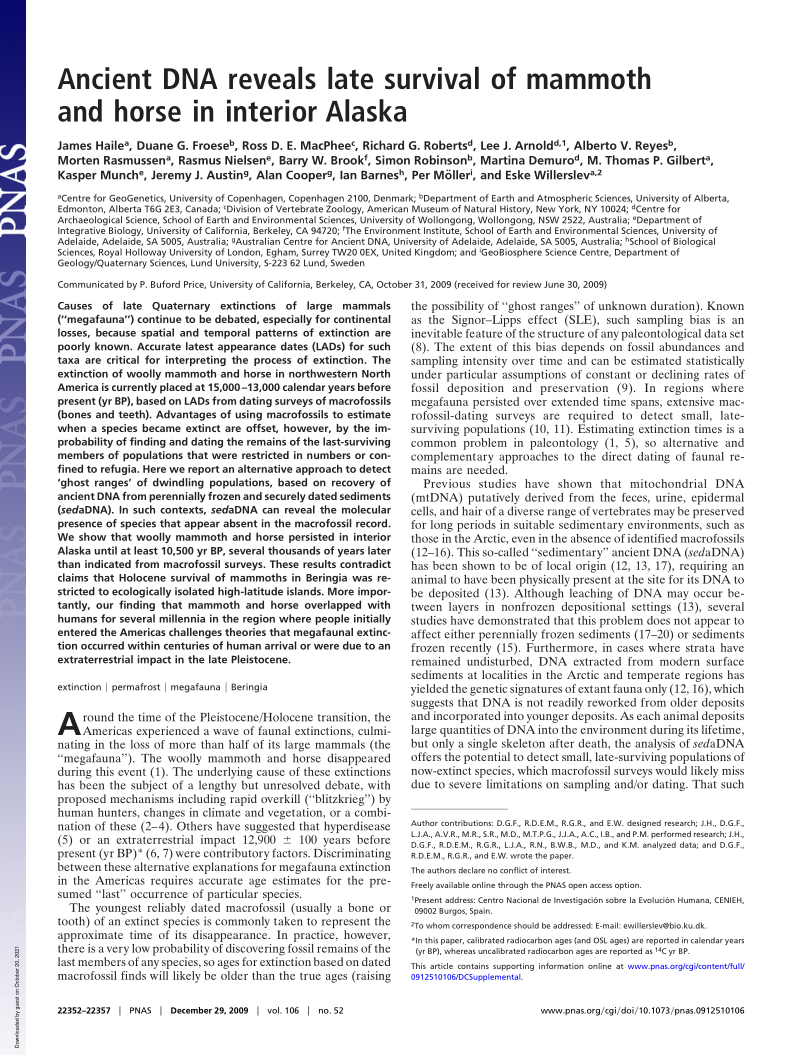James Haile et al argue for dating of horse remains in Alaska to 10500 years BP based on sedimentary DNA analysis.
- Type
- Academic / Technical Report
- Source
- Proceedings of the National Academy of Sciences Non-LDS
- Hearsay
- DirectSecondary
- Reference
James Haile, Duane G. Froese, Ross D. E. MacPhee, Richard G. Roberts, Lee J. Arnold, Alberto V. Reyes, Morten Rasmussen, Rasmus Nielsen, Barry W. Brook, Simon Robinson, Martina Demuro, M. Thomas P. Gilbert, Kasper Munch, Jeremy J. Austin, Alan Cooper, Ian Barnes, Per Möller , and Eske Willerslev, "Ancient DNA reveals late survival of mammoth and horse in interior Alaska," Proceedings of the National Academy of Sciences 106, no. 52 (December 29, 2009): 22352-22357
- Scribe/Publisher
- Proceedings of the National Academy of Sciences
- People
- Proceedings of the National Academy of Sciences
- Audience
- Reading Public
- Transcription
Causes of late Quaternary extinctions of large mammals (‘‘megafauna’’) continue to be debated, especially for continental losses, because spatial and temporal patterns of extinction are poorly known. Accurate latest appearance dates (LADs) for such taxa are critical for interpreting the process of extinction. The extinction of woolly mammoth and horse in northwestern North America is currently placed at 15,000–13,000 calendar years before present (yr BP), based on LADs from dating surveys of macrofossils (bones and teeth). Advantages of using macrofossils to estimate when a species became extinct are offset, however, by the improbability of finding and dating the remains of the last-surviving members of populations that were restricted in numbers or confined to refugia. Here we report an alternative approach to detect ‘ghost ranges’ of dwindling populations, based on recovery of ancient DNA from perennially frozen and securely dated sediments (sedaDNA). In such contexts, sedaDNA can reveal the molecular presence of species that appear absent in the macrofossil record. We show that woolly mammoth and horse persisted in interior Alaska until at least 10,500 yr BP, several thousands of years later than indicated from macrofossil surveys. These results contradict claims that Holocene survival of mammoths in Beringia was restricted to ecologically isolated high-latitude islands. More importantly, our finding that mammoth and horse overlapped with humans for several millennia in the region where people initially entered the Americas challenges theories that megafaunal extinction occurred within centuries of human arrival or were due to an extraterrestrial impact in the late Pleistocene. . . .
Comparison with the Fossil Record. Currently, the youngest macrofossil ages for mammoth and horse north of the Cordilleran and Laurentide ice sheets in northwestern North America are 11,500 ± 160 and 12,480 ± 80 14C yr BP, respectively. These correspond to calibrated (calendar year) age ranges of 13,100–13,710 and 14,180–14,960 yr BP at the 95% confidence interval. The recovery of mammoth and horse DNA from the 10,500- to 7,600-year-old sediments suggests that both species survived in interior Alaska for at least 2,600 and 3,700 years longer, respectively, than established from macrofossil surveys north of the Cordilleran and Laurentide ice sheets. . . .
Concluding Remarks. Animal DNA from modern environmental samples has been used to detect secretive organisms present at low densities, without requiring their direct observation (Fig. 3) (21). Our study shows that the same approach can be extended to extinct animals, to detect their former geographic ranges and lastest appearance dates. For this purpose, we chose the woolly mammoth and horse, finding that small populations of these megafaunal species persisted well into the Holocene in northwestern North America. The prolonged overlap of humans, mammoth and horse, revealed here by the application of the sedaDNA approach, suggests that the timing and process of extinction of other species in the Americas and on other continents should be reassessed using a similar strategy. Furthermore, recognition of their late survival from traces of sedaDNA is of more general importance to the field of Quaternary paleontology, because it demonstrates that ancient DNA preserved in certain sedimentary environments can be used to detect dwindling populations of taxa that will likely be missed using the more traditional approach of finding, and subsequently dating, macrofossils.
Importantly, as sedaDNA cannot be dated directly, it is crucial to acknowledge that the fidelity of the DNA record depends on it being contemporaneous with the associated dated material. This will generally require that the sediments at the study site have remained undisturbed since deposition and that the DNA has not migrated between strata; these constraints apply in addition to other controls on long-term DNA preservation (see SI Text). We recommend, therefore, that sedaDNA analyses should be conducted concurrently with direct dating of macrofossils, rather than as a replacement for it, especially in settings where postdepositional reworking of sediments and fossils cannot be discounted. Nevertheless, coupling the sedaDNA approach with that of recent climatic niche modeling, which can identify likely target areas for late survival of extinct species, offers a powerful tool to reexamine when, where, and why various late Quaternary species went extinct.
- Source Link
- https://ro.uow.edu.au/scipapers/4971/
- Citations in Mormonr Qnas
The B. H. Roberts Foundation is not owned by, operated by, or affiliated with the Church of Jesus Christ of Latter-day Saints.

